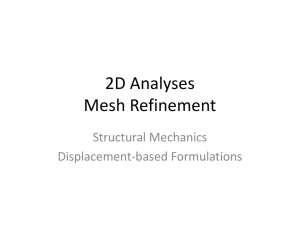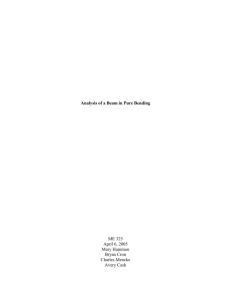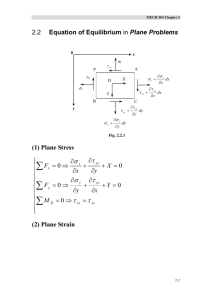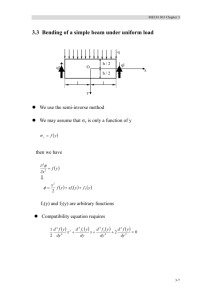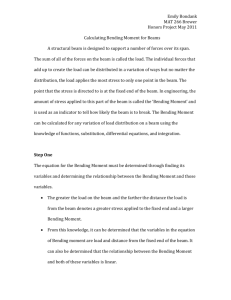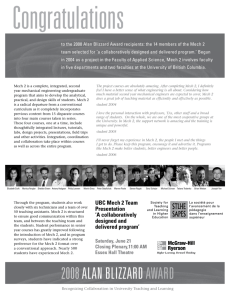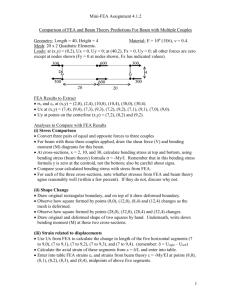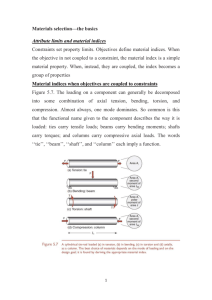Chapter 3 Solution of Plane Problems in
advertisement
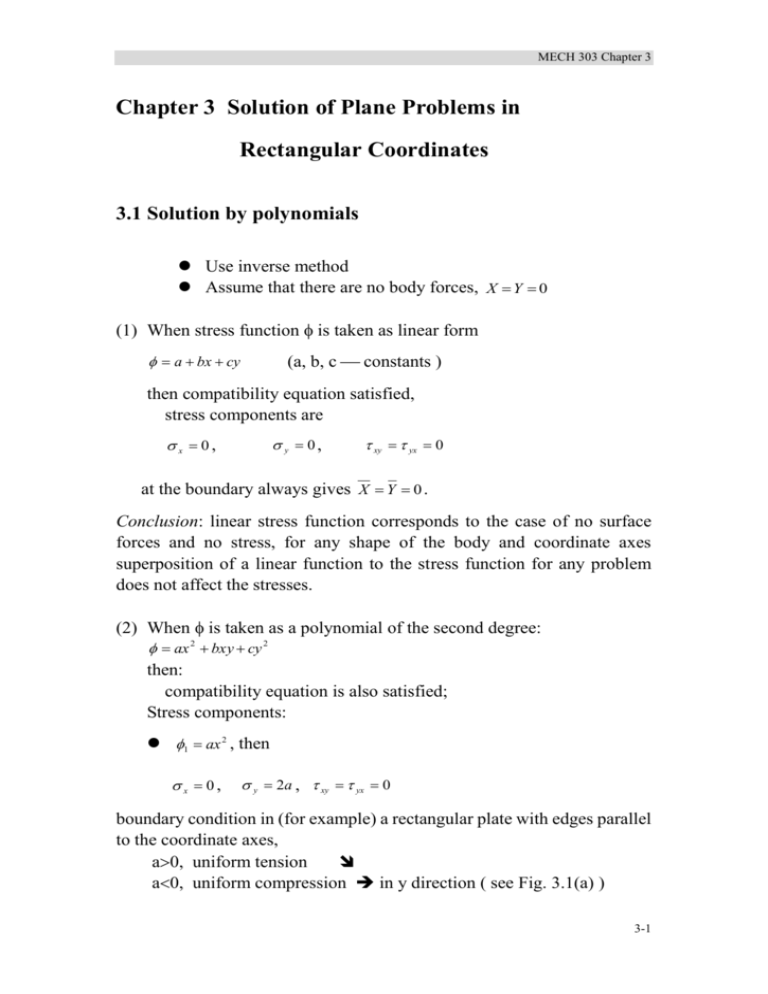
MECH 303 Chapter 3 Chapter 3 Solution of Plane Problems in Rectangular Coordinates 3.1 Solution by polynomials Use inverse method Assume that there are no body forces, X Y 0 (1) When stress function is taken as linear form (a, b, c constants ) a bx cy then compatibility equation satisfied, stress components are x 0, y 0, xy yx 0 at the boundary always gives X Y 0 . Conclusion: linear stress function corresponds to the case of no surface forces and no stress, for any shape of the body and coordinate axes superposition of a linear function to the stress function for any problem does not affect the stresses. (2) When is taken as a polynomial of the second degree: ax 2 bxy cy 2 then: compatibility equation is also satisfied; Stress components: 1 ax 2 , then x 0, y 2a , xy yx 0 boundary condition in (for example) a rectangular plate with edges parallel to the coordinate axes, a0, uniform tension a0, uniform compression in y direction ( see Fig. 3.1(a) ) 3-1 MECH 303 Chapter 3 in other shape of plates, the above solution corresponding to what kinds of boundary surface forces? y y x O x O b 2a b O x b O 2a x 2c 2c b y (a) O x y y (b) (c) Fig. 3.1 2 bxy , then x 0, y 0 , xy yx b (see Fig. 3.1(b)) Hence bxy can solve the problem of a rectangular plate in pure shear. 3 cy 2 , then x 2c , y 0 , xy yx 0 c0 uniform tension in x direction. c0 uniform compression P A P 3-2 MECH 303 Chapter 3 cP 1 2 3 2A superposition of 3 stress states. (3) When is taken as ay 3 then compatibility condition is satisfied. Stress components x 6ay , y 0 , xy yx 0 O h h/2 x x h/2 y Corresponding to the problems of pure bending of a rectangular beam. Relation between constant a and bending moment M and depth of beam h : 6a 12 M h3 Thus x can be expressed as: x 12M My y , y xy 0 3 I h 3-3 MECH 303 Chapter 3 3 where I 1 h 12 , the moment of inertia of the beam section. The bending moment is applied in other manners, Saint-Venant’s principle should be used to obtain the solution. 3.2 Determination of displacements By physical equation For stress solution obtain strain solution By geometrical equation obtain displacements An example in plane stress pure bending: (a) From above stress expressions, we have strains: x M y, EI y M EI y, xy 0 by geometrical equations, we get: u M v M v u y, y, 0 x EI y EI x y From above ( by integration): 3-4 MECH 303 Chapter 3 u M M 2 xy f1 y , v y f 2 x , EI 2 EI f1(y), f2(x) should satisfy: df1 y df 2 x M x dy dx EI Thus df 1 y df 2 x M , x dy dx EI i.e., f 1 y y u 0 , f 2 x M 2 x x v 0 . 2 EI M x O M M A M x O l l y y (b) (a) Thus: u M xy y u 0 , EI v M 2 EI y2 M 2 x x v 0 2 EI The angle of rotation of any vertical line element in beam u M x cross section remains plane after bending y EI All the longitudinal lines (fibers) of the beam will have the same curvature 2v M 2 x EI 1 For displacement boundary condition of simply supported beam (a): u x 0 y 0 0, v x 0 y 0 0, v x l y 0 0, from which we have 3-5 MECH 303 Chapter 3 v0 0 , u0 0 , Ml , 2 EI Finally we have the expressions for displacements components: u M l y x , EI 2 v M l x x M y 2 2 EI 2 EI The deflection of the beam axis is v y 0 M l x x . 2 EI which is the same as the result obtained in mechanics of materials (MECH101). For displacement boundary condition of cantilever beam (b): u x l h h y ~ 2 2 0, v x l h h y 2 2 0 cannot be exactly satisfied by obtained expression for u and v. If we use the conditions in mechanics of materials: u x l y 0 0, v x l y 0 0, v x x l y o 0 then we have Ml Ml 2 , 2 EI EI M M l x 2 M y 2 . v Finally u l x y , EI 2 EI 2 EI u0 0 , v0 The defection of the beam axis is v y o M l x 2 2 EI which is the same result obtained in mechanics of materials (MECH101). In the case of plane strain, we obtain the solution simply by replacing 3-6 MECH 303 Chapter 3 E by by E 1 2 1 3-7

